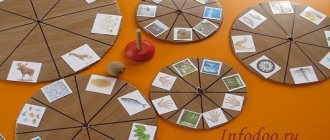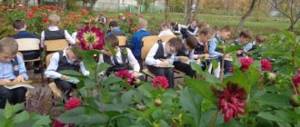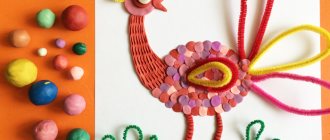Game "Vegetables - Fruits"
Target. Teach children to place toy vegetables and fruits on plates, taking into account color, shape, name; relate the number of objects to the number. Practice highlighting the number of objects on a table. To form ideas about the concepts of “Vegetables” and “Fruits”.
Equipment. Two plastic plates, numbers from 1 to 5, toy vegetables.
Dictionary. Apple, pear, tomato, carrot, orange, vegetables, fruit, red, green, yellow.
Progress of the game.
Option 1.
The teacher shows real vegetables and fruits, then compares them with soft crafts - toys, clarifies the names (showing signs). The teacher lays out all the vegetables and fruits in front of the child sitting opposite him and gives a task: for example, put all the round vegetables, or all the red vegetables, or all the apples, etc. on the plate. The other children watch his actions. Then each participant receives a plate and the task of putting all the round vegetables and fruits (etc.) on the plate. The one who completes the task first wins.
Option 2.
The adult shows the child the number 1 and asks him to put the same number of carrots (cucumbers, etc.) on the plate. If the child finds it difficult, the teacher helps him, laying it out with his hand, and counts with the child using tablets. If the child has coped well with the task, then it can be complicated, for example: “Put 2 cucumbers and 3 oranges.”
Then each participant in the game is tasked with putting as many vegetables on the plate as the adult indicates with a number. The one who completes the task first wins.
Notes. Vegetables and fruits can be sewn from colored oilcloth using old inflatable rings and toys. These items must be tightly stuffed with cotton wool or padding polyester, trying to give them a similar shape.
Do-it-yourself didactic games Performed by teacher Rodyukova V.G. - presentation
Do-it-yourself didactic games Performed by teacher Rodyukova V.G.
Basic provisions about the didactic game The didactic game is both a game method of teaching preschool children, and a form of education, and an independent game activity, and a means of comprehensive education of the child’s personality. A didactic game as a form of teaching children contains two principles: cognitive and playful. All didactic games are divided into three main types: -games with objects (toys, natural materials); - desktop-printed; -word games. Prezentacii.com
The goals of the didactic game are to develop the ability to take on a certain role, follow the rules of the game, and develop its plot. Formation in children of the correct attitude towards the phenomena of social life, nature, and objects of the surrounding world. Systematization and deepening of knowledge about the Motherland and the world as a whole. The development of children's sensory abilities, which underlie the child's knowledge of the environment. Children's speech development: replenishment and activation of vocabulary, formation of correct sound pronunciation, development of coherent speech, ability to correctly express one's thoughts.
Sensory, as an integral part of didactics, poses the following tasks: -development of the child’s intelligence; -systematization of knowledge obtained from the external environment; - formation of an aesthetic sense; -development of imagination, observation and attentiveness; -preparing children for future educational activities; -enrichment of children's vocabulary; - development of various types of memory (visual, figurative, auditory, motor).
Below are handmade didactic games for children from 2 to 7 years old. Many ideas are taken from the Internet, but revised or expanded, so I do not claim authorship, but I hope that the material will be useful for both educators and parents who have small children.
A math tablet is an opportunity for research activities for a child, promoting cognitive development, as well as the development of creative abilities. And this means the development of fine motor skills, differentiated perception, sensorimotor memory, assimilation of generalized knowledge and methods of action. The development of imagination will contribute to obtaining creative results in all types of activities and will ensure full readiness for school education and further success in school. A math tablet will give you the opportunity to master the coordinate system in games.
Developmental board Designed for children from 1.5 to 3 years old, it helps develop fine motor skills, auditory perception, and reinforcement of primary colors. The base is a wooden kitchen board. The materials were purchased at a hardware store.
Finger “Twister” Game objectives: -development of fine motor skills; -endurance training; -promoting tendon stretching; -development of hand joints; -development of communication skills.
“Ladybug” is made of felt, filled with padding polyester, black circles are attached to buttons. The goal is to develop fine motor skills of the hands. The touch piano is made of halves of wide white Velcro for clothing, alternating with each other, and black thin Velcro, attached to Moment Crystal glue. The goal is to develop tactile sensations
Game “Flowers-Leaves” A game similar to “tic-tac-toe” is familiar to each of us since childhood. The goal is the development of logical thinking, training of memory and attention.
Attention game “Arrange according to the pattern” Made from matchboxes glued together (you can use ice containers). The child must arrange the figures according to the pattern in the picture, remember the complication and repeat the drawing. The goal is to develop attentiveness and memory.
Tantamaresques and finger tracks are figures of people or animals made of cardboard, with slots cut out for fingers. Objectives: development of fine motor skills; speech; thinking, attention, memory, imagination. Materials for production: colored cardboard, felt-tip pens, PVA glue, scissors. You can use pictures from coloring books or covers, laminate them or use tape to strengthen them. Finger tracks are good for gymnastics or finger games to strengthen muscles and develop coordination. Materials: buttons, fabric, threads
“Fishing” and “Mathematical Fishing” The “Fishing” game is designed for breathing training. Materials: an aquarium or a small jar, a cocktail tube, paper-cut fish. You can make the game more difficult by writing examples on the back of the paper fish. This version of the game is intended for children of older preschool age and combines breathing training and strengthening counting skills within 10.
Such different fasteners The base is plexiglass. The types of clothing were taken from the Internet, printed and laminated, mounted on Moment Crystal glue. The sneaker is made of denim. Fastening options: a button on a dress, a zipper on a jacket, a belt on a robe made of satin ribbon, Velcro on shoes, a lace on a sneaker. The manual helps the child learn to fasten and unfasten buttons, zippers, laces, thereby developing fine motor skills and children's confidence when dressing for a walk and undressing, which is sometimes a problem for a small child.
Sensory hedgehog - development of fine motor skills of the hands. The leaves are attached to the back of the hedgehog using buttons. The leaves, apples and mushrooms are attached using Velcro.
Igrovisor I made Igrovisor from laminated sheets on a spring: 1 sheet-field of cells for graphic dictations. 2 transparent sheet is needed for completing assignments based on pictures (saving teaching material) 3 white blank sheet for drawing 4 math sheet. I posted the manual “Composition of numbers from 2 to 10” on it. The manual turned out to be multifunctional and practical, because The felt-tip pen is washed off with water.
The flannelgraph is made in the form of a folder: it is sewn from a piece of flannel, and the edges are edged with bias tape. The folder is made from bedding packaging, covered with wallpaper, Velcro is sewn inside on both sides for fastening the fabric, and handles are made from bias tape. The flannelgraph is placed on a stand from a decorative plate. The figures for the flannelgraph are cut out of felt or children's coloring books, and Velcro is glued to the back of the figures.
Noise instruments The tambourine is made from a herring box, in which holes are drilled and fishing bells are inserted, the box itself is covered with colored paper. The rattles are made from disposable spoons with a Kinder Surprise container filled with cereal sandwiched between them. The top is decorated with a thermal sticker for decorating eggs. Finger bells are made from store-bought bells with hair bands threaded through them. The noisemakers are made from soap bubble boxes filled with cereal.
Vegetable garden all year round The manual is used to familiarize children with vegetables growing in the garden, for the game “Gardeners”, for role-playing games “Farm”, “Shop”, etc. A box is taken as a basis, on the sides it is pasted with a drawn fence and cut out paper with grass. The beds are rollers made of brown fabric filled with synthetic padding. The vegetables are sewn from felt and fleece using patterns from the Internet. The cabbage is attached to the bed using Velcro.
To be continued... Thank you for your attention








